Economists are more bullish on the economy, but not on profits
How changes in economic forecasts might lead to changes in the asset allocation of your portfolio
Evelina M. Tainer, Chief Economist
This article summarizes the consensus forecast of the economy by 50 economists polled by Blue Chip Economic Indicators. Depending on your current asset mix, it may lead you to alter your personal allocation of stocks, bonds and cash, or reassure you that your current holdings are about right in their proportions. At the end of the article, you will find a sample asset allocation mix geared toward specific age levels that are adaptable to your personal situation.
That was then, this is now
In August 1998, we used the Blue Chip Economic Indicators consensus forecast to give a sense of what economists were thinking about the direction of economic activity for 1999. At the time, the consensus forecast showed that real GDP would moderate significantly from the 1998 pace and post a rise of 2.3 percent in 1999. The consumer price index was predicted to increase 2.4 percent and corporate profits were to grow 2.6 percent. The 3-month Treasury bill was expected to average 5.2 percent while the 10-year note was going to average 5.8 percent in 1999. On the whole, this forecast was not altogether a friendly one for stock market investors, since it had rising interest rates and sluggish corporate profits.
What a difference a few months makes
The economic outlook is different now, with stronger economic growth, but weaker profits and lower interest rates overall. In the next several paragraphs, we will discuss the new consensus forecast, which reveals a much more optimistic view of the economy than last summer. (Incidentally, the August 1998 forecasts were polled before the tenth of the month, which means that the forecasts were made roughly at the mid-point of the stock market correction.)
The Blue Chip Economic Indicators consensus shows that real GDP is expected to grow 3.3 percent in 1999, 0.6 percentage points less than in 1998, but still one full percentage point faster than was predicted late last summer. The chart below shows the pattern of growth to be evenly spread over the next year. (Economists are now predicting that the year 2000 will see a slowdown with relatively anemic growth in the first quarter. This reflects a slight inventory correction after an inventory build-up in the second half of 1999.)

Consumers don't fail to perform
Consumer spending accounts for about two-thirds of GDP. Certainly it is fair to say that healthy gains in this sector will generate a robust economy (unless consumers purchase foreign-made items). Last August, economists were expecting consumer spending to slow to a 2.8 percent rate, but are looking for a 3.6 percent gain now. As depicted in the chart below, the growth in real personal consumption expenditures exceeded the quarterly gains in real (inflation-adjusted) disposable income in 1998. According to the Blue Chip panel, this trend is likely to continue into 1999 and 2000, albeit at a more moderate pace.
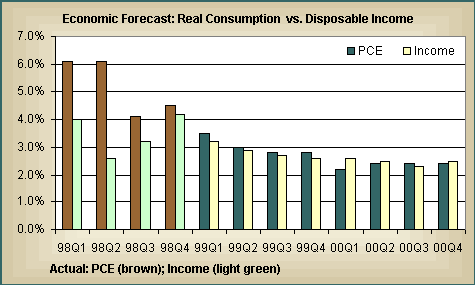
Much has been made about the "wealth effect." This is the theory that consumers are spending more than their income allows because the skyrocketing stock market has increased their wealth (mostly in their pension plans). Fed chairman Alan Greenspan has mentioned this worrisome aspect of consumer spending on several occasions. The Fed chairman is concerned that the overvalued equity market will correct at some point - and this could lead to a dramatic drop in consumer spending as the "wealth effect" shifts in reverse. A sharp plunge in consumer spending would take a big bite out of GDP growth. In turn, this could hamper profit gains.
The Fed chairman has cause to worry. The chart below shows that consumers don't have much of a safety cushion to fall back on. Through the fourth quarter of 1998, the saving rate has fallen to nearly zero. The debt-to-income ratio surged in the past five years to unprecedented levels. After reaching a plateau in 1996 and 1997, consumer dependence on credit usage revived in 1998.
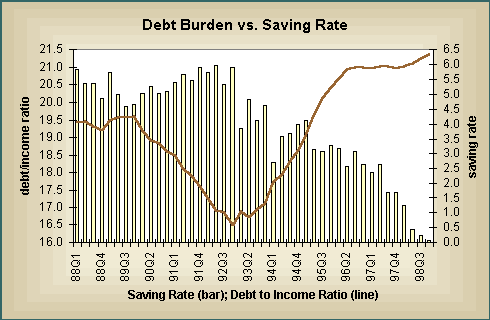
In addition to stock market wealth, consumers have also benefited from a low interest rate environment. Low mortgage rates allowed consumers to refinance their loans - which eventually led to increased cash flow for discretionary items. The downside for 1999 and 2000 is that most mortgage loans available for refinancing are probably completed. As a result, consumers couldn't generate cash flow from their homes again. But, Greenspan noted that the wealth of homeowners has helped to fuel the consumer spending spree (in addition to stock market wealth). As a result, a drop in stock prices might not be as devastating to the economy as some analysts believe.
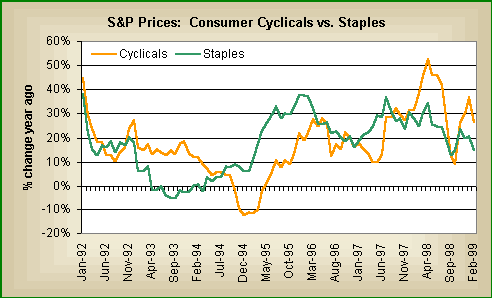
For those individual investors who are also worried about the lack of consumer savings, a defensive posture might be to shift into consumer staples, and away from consumer cyclical companies. As seen in the chart, the two have moved in the same direction, although not by the same magnitude in the past year. Staples are those goods and services that consumers need to buy in good economic times and in bad.
Investment spending should dampen
Just like consumer spending, the Blue Chip consensus forecast was revised higher for investment expenditures on structures and equipment. Economists now expect a 7.8 percent gain relative to a 6.8 percent increase predicted last summer. Investment on structures is expected to be moderate - but up a couple of percentage points after a relatively anemic year in 1998. In contrast, spending on producers' durable equipment is expected to grow about 10 percent in early 1999, and then slow to a 5 percent rate in the year 2000. This would clearly be weaker than the 16.6 percent jump recorded in 1998.

It is interesting that the Blue Chip forecast shows such a healthy picture for investment expenditures. The chart below reflects year-over-year changes in business fixed investment (structures plus producers' durable equipment) versus the year-over-year growth in after-tax profits. The correlation between these two series is high - faster profits tend to propel investment spending. Yet, in the past two years, the two series have diverged. Indeed, the Blue Chip consensus expects corporate profits to rise less today (+1.9 percent) than in August 1998 (+2.4 percent). It is intriguing that the Blue Chip economists are predicting faster investment spending with weaker profit growth - which extends the divergence over a longer time frame.
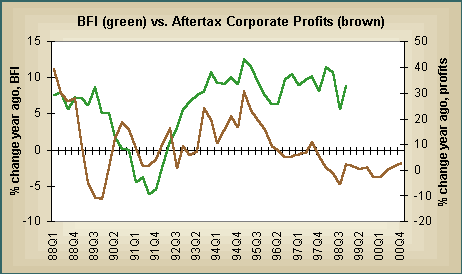
On the residential side, the Blue Chip panel expects investment spending to increase less rapidly in 1999 than in 1998. In the year 2000, housing investment is expected to decrease outright. Equity prices have already registered peak gains in the furniture and appliance sector in early 1998. Some modest gains might be expected in early 1999, as slower housing expenditures might already be priced in this industry. Note the modest gains posted in equity prices of capital goods companies in the past couple of months.
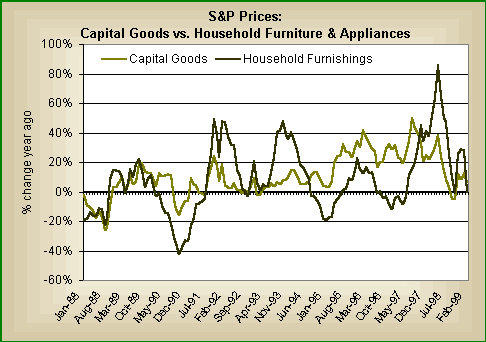
Net exports are still a drag
First came the collapse of Southeast Asian economies in the fall of 1997, then the Russian economy and banking system fell apart in the summer of 1998. The winter of 1999 brought foreign currency problems and recession to Brazil. What are the implications for the United States? Aptly phrased by Fed chairman Alan Greenspan, the U.S. economy is an oasis of prosperity. This means that as U.S. growth surpasses that of our trading partners, we are likely to buy more imports than sell exports. The green line in the chart below already shows that exports grew a meager 2 percent in 1998 - after the healthy 12 percent gain posted in 1997.
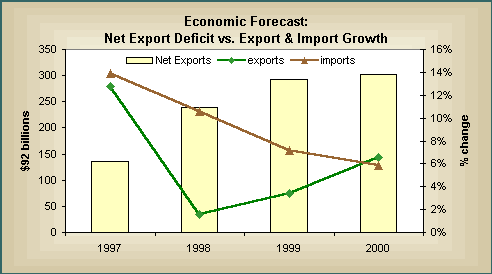
The Blue Chip panel expects that net exports will be a drag on GDP growth in 1999, albeit less than the downdraft caused in the previous year. Indeed, economists are predicting that export growth will turn around this year and accelerate in the year 2000. At the same time, they are looking for a moderation in imports. Remember, though, that healthy growth in consumer spending sometimes benefits foreigners, not just producers of domestic goods. The healthy pace predicted for consumption expenditures in 1999 could generate higher import demand than predicted by the Blue Chip consensus and dampen GDP growth and domestic profits.
Inflation remains subdued
The rate of inflation moderated in 1998 to increase 1.6 percent, as consumers benefited by a worldwide glut in oil that held down energy prices. At the same time, a good harvest hampered food price gains. And there is no question that a disastrous economic environment in Southeast Asia held down prices of tradable goods.
The Blue Chip Economic Indictors consensus predicts a slight acceleration in the CPI in 1999. In August 1998, the consensus forecast was that the CPI would rise 2.4 percent rise in 1999, but this was revised down to a 1.9- percent gain in the March 1999 forecast. Crude oil prices have surged in the first half of the month, which may lead to an upward revision in inflation once again. While a low rate of inflation increases the purchasing power of consumers, it may hamper the pricing power of corporations in this global competitive environment. Consequently, profit gains are curtailed.
Labor markets are still tight
Ever since the unemployment rate fell below 5.5 percent a couple of years ago, market analysts and Federal Reserve officials have worried that tight labor markets would lead to accelerating inflation. Wages have picked up - rising faster than the consumer price index. Yet, the CPI has not yet accelerated. The Blue Chip panel expects the jobless rate to average 4.4% in 1999, 0.3 percentage points less than they thought last summer. (Incidentally, the outlook for 2000 is also favorable with the rate ticking up to 4.6 percent even as economic growth slows by one percentage point.) Tight labor markets with even slightly rising compensation costs hurt corporate profits. Yet, the positive offset here comes from improved productivity gains.
It is a low interest rate environment
The interest rate outlook has also changed in the past seven months. Economists are now predicting that short-term rates - measured by the 3-month Treasury bill - will average 4.5 percent in 1999, down 0.3 percentage points from the 1998 average of 4.8 percent. At the same time, the average interest rate level for the 10-year Treasury note is expected to yield 5 percent this year, compared with a 5.3 percent average last year. The interest rate forecast shows a reduction of more than ½ percentage point from the August 1998 forecast.
Three main factors account for the low rates. In the past year, treasury securities served as a safe haven investment for all investors - but particularly those trying to get out of emerging markets. Demand for the risk-free Treasury securities skyrocketed - and yields fell. At least some of the down drift was noted in corporate securities as well. Another favorable factor for dampening interest rate levels is the dramatic slowdown in the growth of public debt. (For more discussion on this topic, read the February Focal Point.) Finally, the low inflation environment has also led to lower interest rates.

THE BOTTOM LINE FOR INVESTORS
The consensus among investment professionals is that chasing last year's best mutual fund performer is a lost cause and won't help you achieve the highest possible rate of return. Rather, an appropriate asset allocation of stocks, bonds, and cash is more likely to generate favorable returns for investors.
Individual investors must choose an asset allocation mix that is appropriate to their risk preferences as well as their personal goals and life situations. In the past month, most of the chief market strategists of the major investment banks have announced some changes in asset allocation. The changes were not dramatic but tended to shift away from stocks and into bonds. Nevertheless, these still showed a larger portion in equities (more than 50 percent) rather than fixed income. The resident bull in the United States, Abby Joseph Cohen, market strategist at Goldman Sachs, revised down her stock recommendation to 70 percent, from 72 percent, for example.
Age determines portfolio mix
A few weeks ago, the cover story in Business Week (2/22/99) focused on consumers making their own investment decisions now that so many investment firms allow an individual to buy and sell securities so easily on the web. The article suggested individual investors might best be served by investing only in index funds. The article offered three portfolio options where the asset allocation mix depended on the investor's age. In each case, the allocation is considered medium risk. (The 35-year old is at the beginning of her career; the 45-year old is at mid-career; and the 55-year old investor is at her career's peak.)
|
Investor Portfolio |
Large-Cap Stocks |
Small-Cap Stocks |
International Stocks |
Fixed Income |
Expected Annual Return |
| 35-years old | 46% | 18% | 21% | 15% | 10.9% |
| 45-years old | 37% | 15% | 18% | 30% | 10.0% |
| 55-years old | 32% | 12% | 14% | 42% | 9.2% |
While Econoday does not endorse any specific asset allocation mix because it is dependent on the individual investor's goals and risk preferences, we thought that the portfolios recommend by Business Week serve as a good departure point for investors to consider. And one doesn't necessarily have to apply these potential portfolios only to index funds.